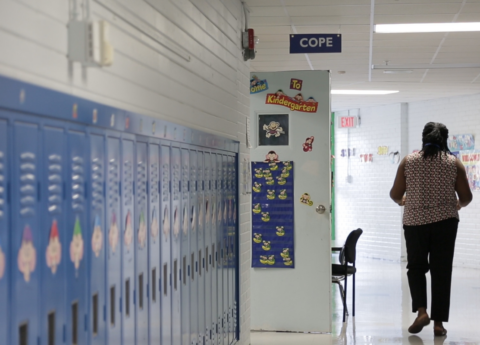Kentucky adopted innovative policies beginning in the late 1990s to help low-income adults attend community college while receiving the supports they need to succeed in school. But shrinking public dollars and increasingly strict federal rules are making it harder to scale those innovations up.
Helping More Kentuckians Get the Skills They Need
Congress passed welfare reform in 1996, which eliminated Aid to Families with Dependent Children (AFDC)—a program that provided cash assistance to low-income families—and replaced it with Temporary Assistance for Needy Families (TANF). TANF is a block grant program that includes work participation requirements for those receiving public assistance and puts a time limit on how long families can receive benefits.
Many states implemented TANF in a way that discouraged recipients from attending college and focused simply on reducing the welfare rolls, whether or not families’ lives improved as a result. Kentucky, however, recognized the critical role of education in helping people obtain jobs with family-sustaining wages.
The state passed legislation in 1998 requiring the Cabinet for Health and Family Services to “take all necessary actions to ensure that parents receiving public assistance may engage in educational and vocational programs where assessment shows their chances of achieving self-sufficiency will improve.” The law requires case managers to regularly inform TANF recipients about educational opportunities. And regulations passed at the time allow TANF recipients to attend college full-time for up to two years without being required to participate in other work activities.
To increase those recipients’ chance of success in higher education, the state created the Ready to Work (RTW) program. The program places Ready to Work coordinators at each community college campus throughout the state. The coordinators serve as mentors, counselors, advocates, tutors and case managers for TANF recipients enrolled in postsecondary education. The coordinators help recipients make career plans; identify a program of study; access financial aid; obtain other supports through TANF and the community including help with child care and transportation; and get academic assistance.
The coordinators also help participants access a second key component of the program—a work study job. Participants have the option of signing up for work study positions that provide them with income that does not reduce their TANF cash benefit. RTW participants typically go through two tiers of work study. The first placement is either on campus or in a non-profit organization and is focused on the soft skills of employment. The second is more personalized and tied to the participant’s job goals—and is usually off-campus. Although work study is optional under RTW, in a recent year 59 percent of RTW participants were engaged in TANF-funded work study and 19 percent in federal work study (with some overlap between the two).
Results from RTW are very positive. TANF recipients in Kentucky are more likely to be enrolled in college than the adult population as a whole. The school retention rate of RTW participants is higher than for the entire system, and the average grade point average (GPA) of participants has been on par or better than the system-wide GPA. Graduation rates have been good, and RTW participants are more likely to receive associate’s degrees than the community college population as a whole, where certificates are more common.
A study published by the Kentucky Legislative Research Commission in 2004 shows that RTW is paying off in higher rates of employment and better wages. Compared to TANF recipients participating in other work-related activities, those in the category receiving education and training including RTW participants had the highest employment rate upon leaving the program, the highest job retention rate a year later, and the highest average annual wage of all categories by about $3,500 a year.
Building on the success of RTW, the state created the Work and Learn (WAL) program in 2003. WAL targets those TANF recipients with lower levels of education—those working toward a GED as well as high school graduates brushing up on basic skills before entering college. Like RTW, WAL has coordinators throughout the state that provide counseling and help participants access work study opportunities while attending adult basic education or remedial education classes. Results are also strong. A majority of WAL participants without a high school credential get a GED and many are making the transition into postsecondary education.
Barriers to Success Increase
However, a number of challenges are making it increasingly difficult to scale up these successful initiatives. One challenge has been meeting the federal work participation benchmarks of the TANF program. Although Kentucky allows up to two years of full-time study for TANF recipients, only one year without a work activity of at least 20 hours a week can be counted toward the federal requirements. Federal law puts a cap on the share of recipients enrolled in education without other work activities, and Kentucky has surpassed this cap a few times. In part because of this difficulty, the state put more TANF money into work study programs beginning in 2009 in order to avoid being penalized by the federal government. And Congress’ 2005 reauthorization of the welfare reform law contained onerous new reporting and documentation requirements for how TANF recipients are spending their time, forcing case managers to focus more on administrative tasks rather than assisting recipients.
Another challenge is that Congress has not increased the TANF block grant since its inception in 1996, meaning it has lost about 30 percent of its value. That’s made it harder to fund RTW and other supports paid for with TANF dollars. Because of limited money to meet the demand for RTW, the state began limiting RTW services to those actually receiving TANF cash assistance rather than the larger category of TANF-eligible students (who for various reasons may not actually be receiving a TANF cash benefit). That has decreased the number of RTW participants from around 2,500 students per year in the mid-2000s to around 1,500 a year.
The freezing of the block grant has also meant that recipients’ cash benefit hasn’t gone up since 1996, making it harder for families receiving cash assistance to make ends meet. For a family of 3, the benefit is only $429 a month, a drop of 31 percent since 1996 in real dollars. At the same time, the costs of higher education and the supports low-income people need to succeed in school are going up. State budget cuts in higher education are leading to rising tuition while only about 1/3 of those who qualify for need-based state college financial aid actually receive help due to a lack of funds. The cost of the GED is about to double to $120 at the end of this year. And the state has reduced eligibility for child care subsidies to the lowest level in the country.
The still-weak economy also makes it harder for those leaving TANF or receiving a degree to find decent employment. While during the strong economy of the late 1990s many people could find jobs that paid rising wages, now there are three job seekers for every job, and wages are stagnating or even declining. Because TANF is a block grant unlike SNAP or unemployment insurance, it also didn’t respond to the growing poverty caused by the recession through automatically providing assistance to the newly-poor.
The state took real strides over the past 15 years in making education more accessible for low-income families struggling to make ends meet. But less state and federal money for higher education and for the supports needed to succeed—in addition to increasingly stringent work participation rules for TANF in the face of an economy with too few jobs—mean Kentucky’s success is in danger of eroding.



